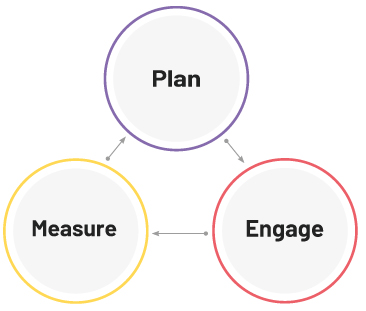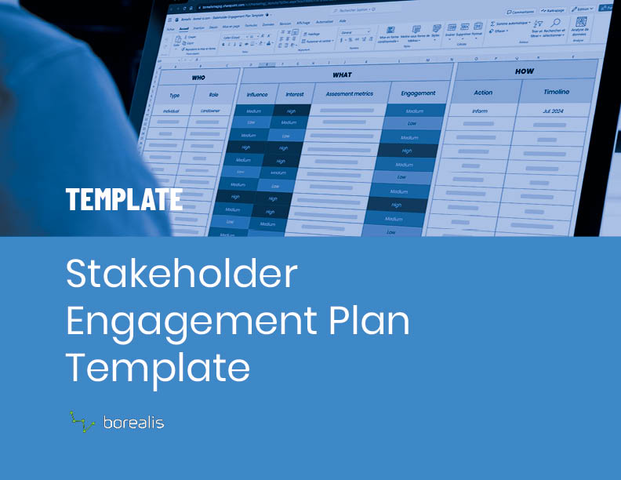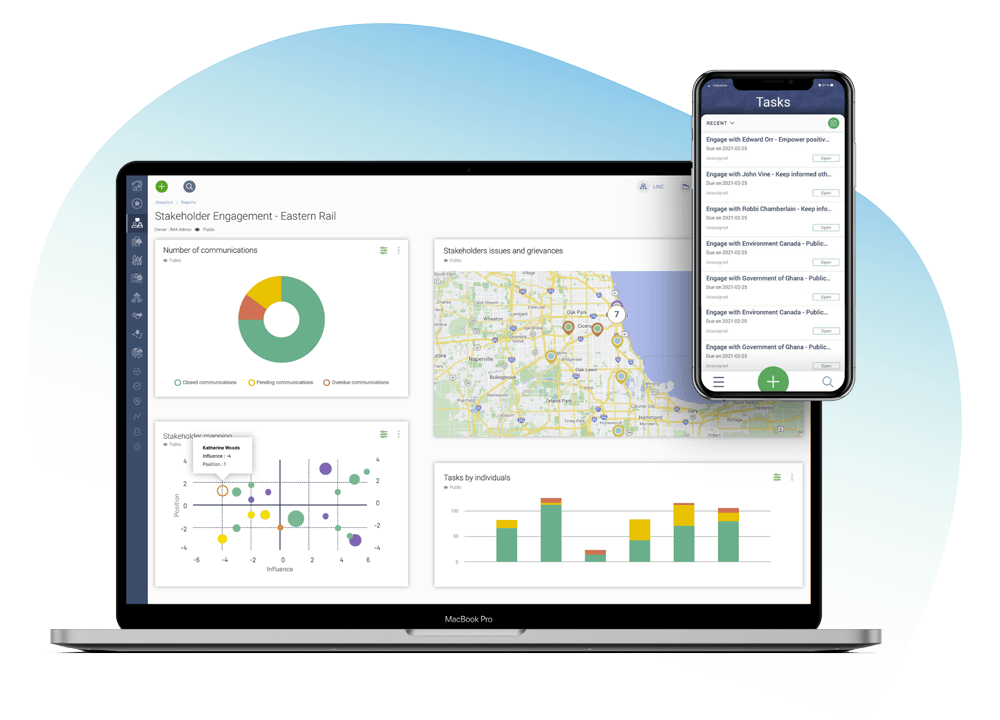As a result, companies can no longer ignore or underestimate the importance of managing stakeholder engagement for both individual projects and long-lasting business success.
Defining stakeholder engagement
At its simplest, stakeholder engagement involves providing information to individuals, community groups, government regulatory bodies, environmental organizations, financial lenders, etc., and receiving feedback from each regarding your company and its business activities or its projects and potential impacts.
Engagement can take many forms, whether through education, consultation or participation in problem-solving processes – but at its heart – is strategic communication that seeks to acknowledge stakeholder concerns and engage in collaborative decision-making to solve complex problems.
Why engage stakeholders?
Better overall decision-making
Cost savings
By engaging stakeholders, identifying risks and removing bottlenecks before they happen, companies can allocate resources more effectively and improve their chances of finishing projects on time and on budget.
Competitive advantage
Heightened reputation
When you engage stakeholders, co-create win-win outcomes and implement deliverables that meet or exceed their expectations, you build trust, credibility and loyalty and enhance your reputation as a competent, credible, reliable and responsible organization.
What's involved in managing stakeholder engagement?
The three steps involved in managing stakeholder engagement are: planning, engaging and measuring. This process is cyclical, and the measuring of the outcomes almost always results in a new planning stage. Implementing a thorough process can help you and your organization achieve considerable gains.

Planning
Your stakeholder engagement plan is the foundation for initiating all your outreach activities.
The goal of the plan is to:
- Assess the potential benefits and drawbacks of your project
- Identify impacted stakeholders
- Understand how various stakeholders might positively or negatively affect project outcomes
- Develop a strategy for communicating and collaborating to ensure project success
Step 1: Assess project risks, opportunities and issues
Start by identifying regulatory requirements
From siting and permitting to detailed environmental assessments, projects, both small and large, must show compliance with regulations and requirements. These can be internal and self-regulatory, as in the case of many industry-based standards but are often external and imposed by various levels of government.
Working with experts to identify and document your project’s regulatory and other requirements can help create greater clarity for all participants and result in better project design.
Determine project benefits and drawbacks
To surface hidden risks, opportunities, benefits and drawbacks, try categorizing your project’s impact under social, health + safety, employment, environmental, economic and security headings and see what you come up with.
Step 2: Identify and classify stakeholders
Once you’ve determined your project’s risks, opportunities, benefits and drawbacks, it should be easier to identify the individuals and groups most likely to be impacted and to what extent.
It’s also important to remember that not all people affected by the project (PAP) will be key stakeholders and that not all key stakeholders will be PAP. For example, although leaders of environmental advocacy groups may not live or work within the project area, they will, nevertheless, wield significant influence over your project’s success.
Analyze and prioritize stakeholders
Once you know who they are, stakeholder analysis and mapping will help you understand and prioritize stakeholders according to:
- Their needs, motivations and expectations
- Their level of interest in your project
- Their level of power and influence
- The risks they represent to your project
- What constitutes value for them
- How they measure success
- Their engagement and communication preferences
Stakeholder analysis, mapping and prioritization allow you to focus the bulk of your engagement efforts on stakeholders with the most power and interest in your project.
Step 3: Define objectives
With a clearer understanding of potential project issues and information about who your key stakeholders are, you’re ready to create your engagement objectives.
Having a clear set of objectives is essential. Not only will they form the basis against which you’ll measure your stakeholder engagement plan, but knowing where you’re starting from and where you want to get to will help keep your engagement activities on track.
For example, in the case of a planned highway extension project, stakeholder engagement objectives might include:
- Gathering feedback and information from stakeholders to help guide route selection and design.
OR…
- Improving community well-being, as measured by the number of influential stakeholders who strongly agree with the statement: “The new highway extension has improved access to healthcare facilities for my community.”
Step 4: Determine your complaint management and follow-up procedures
Before you do, you’ll want to define what constitutes a grievance and set up a process that allows you to record, assess, investigate, escalate and resolve them in a timely manner.
The process should allow anonymous posters to receive status updates without compromising their identity and allow you to analyze, classify and prioritize issues and complaints based on their potential impact on the project. You should also be able to report on the number, type and status of issues or complaints in real-time.
Stakeholder management software that lets you implement a grievance and feedback portals is invaluable in this respect, as it allows you to track stakeholder complaints from initial receipt to resolution and ensures grievances are dealt with quickly by assigning the complaint to the team member best able to handle the issue. You can also monitor and calculate the time spent on each step of the grievance management process, view compensation payouts where applicable and track the project’s overall cost of complaint resolution.
Step 5: Determine your monitoring and reporting process
You can only improve what you can measure. Having a straightforward process in place for monitoring and reporting stakeholder activities allows you to understand how you’re progressing on project and engagement objectives and whether you’re meeting the needs of key stakeholders.
Monitoring and reporting activities help everyone stay informed and accountable, while also creating an environment of transparency. Moreover, lessons learned from these activities can be used to guide future projects.
Stakeholder engagement software simplifies monitoring by allowing you to document and organize all engagements and any notations appended to them – whether done via email, phone/SMS, in person or on social media – into a centralized, searchable database updated in real-time.
This can be incredibly helpful when you’re several years into a project, and you need to reference a specific engagement that took place at its beginning or when you want to generate a report on all outstanding grievances or commitments.
More robust stakeholder engagement software includes in-depth analytical tools and AI capabilities that turn your data into insights so you can:
- Track trends and spot problems in real-time
- Keep a closer eye on KPIs
- Illustrate the results of your queries in easy-to-understand graphs, tables and reports
Learn more about how to measure stakeholder engagement effectively.
Step 6: Build your engagement plan and timeline
With most of your planning elements in hand, you’re ready to detail specific stakeholder engagement activities and develop a timeline for their implementation.
You’ll want to:
- Identify the audiences for each engagement
- Create core messages specific to them
- Identify methods of communication
- Determine the frequency of engagement
- Plan public consultations and outreach
Your stakeholder engagement plan should include all key dates and actions, including when final decisions need to be made on various issues and by whom.

Step 7: Assign responsibilities
This step involves listing your organization’s resources and capacity to identify any knowledge or skill gaps that could prevent you from successfully implementing your engagement plan. If the gaps are substantial, you may need to hire or engage outside assets.
You’ll want to clearly identify roles and responsibilities as well, so team members can coordinate, not duplicate their efforts.
Step 8: Set a budget
Your stakeholder engagement plan should include a detailed budget that allows you to implement meaningful stakeholder engagement activities and monitor and report on them as efficiently as possible.
Depending on the resources available and the nature of the project, you might also need to include financing for:
- Hiring and training staff or outside consultants
- Producing and translating communication or educational materials
- Organizing and executing community consultations
- Purchasing stakeholder software
You’ll want to review your budget regularly to ensure you have the financial resources to meet any new commitments or deliverables that result from stakeholder interactions.
Step 9: Get feedback on your plan
Before you implement your stakeholder engagement plan, it’s important to run it by your stakeholder groups for final feedback. This will help reveal any oversights and ensure your plan aligns with company objectives, stakeholder expectations and regulatory requirements.
Engage your stakeholders
Measure outcomes
Measuring stakeholder engagement outcomes over the entire project lifecycle allows you to continually adjust and refine your plan in response to new issues or stakeholders that emerge as the project moves forward.
Using a fit-for-purpose stakeholder engagement management system like Borealis Software to monitor and report on all activities can assist you in determining what’s working and what isn’t so you can course-correct quickly.
Manage Your Stakeholder Engagement Efforts with Confidence

Request a demo of Borealis stakeholder management software to see how Borealis can help take your stakeholder engagement to the next level. Plan, record, monitor and measure engagement activities within a single application and access information, 24/7, from any device.





